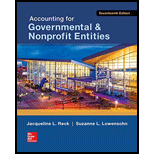
Accounting for Governmental & Nonprofit Entities
17th Edition
ISBN: 9780078025822
Author: Jacqueline L. Reck James E. Rooks Distinguished Professor, Suzanne Lowensohn, Earl R Wilson
Publisher: McGraw-Hill Education
expand_more
expand_more
format_list_bulleted
Textbook Question
Chapter 12, Problem 15.7EP
Which of the following does not represent a performance measurement group under the balanced scorecard?
- a. Customer.
- b. Internal business processes.
- c. Economy and efficiency.
- d. Learning and growth.
Expert Solution & Answer
Want to see the full answer?
Check out a sample textbook solution
Students have asked these similar questions
Compute it's return on equity for 2015 general accounting
Provide correct answer
None
Chapter 12 Solutions
Accounting for Governmental & Nonprofit Entities
Ch. 12 - Are governments and not-for-profit organizations...Ch. 12 - What is the difference between two types of...Ch. 12 - Describe the advantages of performance budgeting...Ch. 12 - Prob. 4QCh. 12 - Identify some essential components of the annual...Ch. 12 - Prob. 6QCh. 12 - Prob. 7QCh. 12 - Prob. 8QCh. 12 - Prob. 9QCh. 12 - Prob. 10Q
Ch. 12 - Prob. 13CCh. 12 - Budgets of government entities a. Are integrated...Ch. 12 - Which of the following statements regarding...Ch. 12 - Which of the following steps would not usually be...Ch. 12 - The budgeting principle in generally accepted...Ch. 12 - Prob. 15.5EPCh. 12 - An approach to budgeting that requires the very...Ch. 12 - Which of the following does not represent a...Ch. 12 - Prob. 15.8EPCh. 12 - Prob. 15.9EPCh. 12 - Prob. 15.10EPCh. 12 - The police chief of the Town of Meridian submitted...Ch. 12 - Prob. 17EPCh. 12 - Prob. 18EPCh. 12 - Prob. 19EPCh. 12 - Prob. 20EPCh. 12 - The U.S. Office of Management and Budget (OMB)...
Knowledge Booster
Learn more about
Need a deep-dive on the concept behind this application? Look no further. Learn more about this topic, accounting and related others by exploring similar questions and additional content below.Similar questions
- Outline three (3) ways that conflicts of interest should be managed by tax agents. In relation to the two (2) conflict examples that you identified in question 1, explain how each one of these conflicts should be managed.arrow_forwardNovak Company has the following stockholders' equity accounts at December 31, 2025. Common Stock ($100 par value, authorized 7,600 shares) $459,100 Retained Earnings 266,700 a. Prepare entries in journal form to record the following transactions, which took place during 2026 1. 290 shares of outstanding stock were purchased at $97 per share. (These are to be accounted for using the cost method.) 2. A $22 per share cash dividend was declared. 3. The dividend declared in (2) above was paid. 4. The treasury shares purchased in (1) above were resold at $101 per share. 5. 500 shares of outstanding stock were purchased at $103 per share. 6. 380 of the shares purchased in (5) above were resold at $96 per share. b. Prepare the stockholders' equity section of Novak Company's balance sheet after giving effect to these transactions, assuming that the net income for 2026 was $86,300. State law requires restriction of retained earnings for the amount of treasury stock.arrow_forwardResearch and Explain the current academic qualifications and relevant experience requirements, for tax agents to be to be registered under the Tax Agent Services Regulations 2009. (150 words)arrow_forward
- Don't use aiarrow_forwardWhat characterizes the faithful representation principle in accounting ?arrow_forwardNovak Company has the following stockholders' equity accounts at December 31, 2025. Common Stock ($100 par value, authorized 7,600 shares) $459,100 Retained Earnings 266,700 a. Prepare entries in journal form to record the following transactions, which took place during 2026 1. 290 shares of outstanding stock were purchased at $97 per share. (These are to be accounted for using the cost method.) 2. A $22 per share cash dividend was declared. 3. The dividend declared in (2) above was paid. 4. The treasury shares purchased in (1) above were resold at $101 per share. 5. 500 shares of outstanding stock were purchased at $103 per share. 6. 380 of the shares purchased in (5) above were resold at $96 per share. b. Prepare the stockholders' equity section of Novak Company's balance sheet after giving effect to these transactions, assuming that the net income for 2026 was $86,300. State law requires restriction of retained earnings for the amount of treasury stock.arrow_forward
arrow_back_ios
SEE MORE QUESTIONS
arrow_forward_ios
Recommended textbooks for you
- Principles of Accounting Volume 2AccountingISBN:9781947172609Author:OpenStaxPublisher:OpenStax College
 Cornerstones of Cost Management (Cornerstones Ser...AccountingISBN:9781305970663Author:Don R. Hansen, Maryanne M. MowenPublisher:Cengage Learning
Cornerstones of Cost Management (Cornerstones Ser...AccountingISBN:9781305970663Author:Don R. Hansen, Maryanne M. MowenPublisher:Cengage Learning Managerial AccountingAccountingISBN:9781337912020Author:Carl Warren, Ph.d. Cma William B. TaylerPublisher:South-Western College Pub
Managerial AccountingAccountingISBN:9781337912020Author:Carl Warren, Ph.d. Cma William B. TaylerPublisher:South-Western College Pub  Financial And Managerial AccountingAccountingISBN:9781337902663Author:WARREN, Carl S.Publisher:Cengage Learning,
Financial And Managerial AccountingAccountingISBN:9781337902663Author:WARREN, Carl S.Publisher:Cengage Learning,

Principles of Accounting Volume 2
Accounting
ISBN:9781947172609
Author:OpenStax
Publisher:OpenStax College

Cornerstones of Cost Management (Cornerstones Ser...
Accounting
ISBN:9781305970663
Author:Don R. Hansen, Maryanne M. Mowen
Publisher:Cengage Learning

Managerial Accounting
Accounting
ISBN:9781337912020
Author:Carl Warren, Ph.d. Cma William B. Tayler
Publisher:South-Western College Pub

Financial And Managerial Accounting
Accounting
ISBN:9781337902663
Author:WARREN, Carl S.
Publisher:Cengage Learning,
Elements of cost | Direct and Indirect: Material, Labor, & Expenses; Author: Educationleaves;https://www.youtube.com/watch?v=UFBaj6AHjHQ;License: Standard youtube license